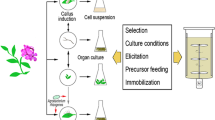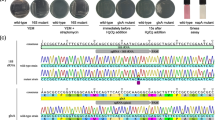Abstract
Ganoderma multipileum is a medicinal mushroom possessing potent medicinal secondary metabolites. However, in order to improve metabolic activity via molecular breeding, optimized protoplasting, regeneration and genetic transformation systems are mandatory but remain unexplored in G. multipileum. Thus, we sought to fill this gap by testing different parameters for protoplasting, regeneration, and genetic transformation based on the carboxin resistance marker gene. According to our results, the best viable protoplasting conditions were pH 6.0, mycelia age 4 days, enzyme concentration 7.5 mg/mL, 0.6 M sucrose osmoticum and 3 h of enzyme digestion. In a transformation study, a carboxin resistance gene cassette was constructed using PCR mutagenesis and restriction digestion of the native succinate dehydrogenase subunit B gene in G. multipileum. A PCR-restriction fragment length polymorphism strategy was also applied by PCR point mutagenesis to create an AgeI restriction site. The transformation system using carboxin resistant cassette proved amenable. The Sdh gene structure showed an intron structure similar to that of other Basidiomycetes and Ascomycetes. Alignment and analysis of the Sdh gene sequences in numerous fungi revealed conservation at a carboxin resistant point mutation site that could be applied to a wide range of fungal species. Further Sdh gene phylogenetic analysis revealed congruence with species phylogeny but with low bootstrap supporting values.





Similar content being viewed by others

References
Austin B, Hall RM, Tyler BM (1990) Optimized vectors and selection for transformation of Neurospora crassa and Aspergillus nidulans to bleomycin and phleomycin resistance. Gene 93:157–162
Avalos J, Geever RF, Case ME (1989) Bialaphos resistance as a dominant selectable marker in Neurospora crassa. Curr Genet 16:369–372
Case ME, Schweizer M, Kushner SR, Giles NH (1979) Efficient transformation of Neurospora crassa by utilizing hybrid plasmid DNA. Proc Natl Acad Sci USA 76:5259–5263
Chen S, Xu J, Liu C, Zhu YJ, Nelson DR, Zhou SG, Li CF, Wang LZ, Guo X, Sun YZ, Luo HM, Li Y, Song JY, Henrissat B, Levasseur A, Qian J, Li JQ, Luo X, Shi LC, He L, Xiang L, Xu XL, Niu YY, Li QS, Han MV, Yan HX, Zhang J, Chen HM, Lv AP, Wang Z, Liu MZ, Schwartz DC, Sun C (2012) Genome sequence of the model medicinal mushroom Ganoderma lucidum. Nat Commun 3:913. doi:10.1038/ncomms1923
Chyr R, Shiao MS (1991) Liquid chromatographic characterization of the triterpenoid patterns in Ganoderma lucidum and related species. J Chromatogr A 542:327–336. doi:10.1016/S0021-9673(01)88771-9
Curtis W (1781) Flora Londinensis: or plates and descriptions of such plants as grow wild in the environs of London. William Curtis, London, p 530
Drocourt D, Calmels T, Reynes JP, Baron M, Tiraby G (1990) Cassettes of the Streptoalloteichus hindustanus ble gene for transformation of lower and higher eukaryotes to phleomycin resistance. Nucleic Acids Res 18:4009
Fries EM (1821) Systema Mycologicum, sistens fungorum ordines, genera et species. Gryphiswaldiae Sumtibus Ernesti Mauritti 1:353
Honda Y, Matsuyama T, Irie T, Watanabe T, Kuwahara M (2000) Carboxin resistance transformation of the homobasidiomycete fungus Pleurotus ostreatus. Curr Genet 37:209–212
Hou D (1950) A new species of Ganoderma from Taiwan. Q J Taiwan Mus 3:101–105
Huelsenbeck JP, Ronquist F (2001) MRBAYES; Bayesian inference of phylogenetic trees. Bioinformatics 17:754–755
Hynes MJ, Corrick CM, King JA (1983) Isolation of genomic clones containing the amdS gene of Aspergillus nidulans and their use in the analysis of structural and regulatory mutations. Mol Cell Biol 3:1430–1439
Kamper J, Reichmann M, Romeis T, Bolker M, Kahmann R (1995) Multiallelic recognition: nonself-dependent dimerization of the bE and bW homeodomain proteins in Ustilago maydis. Cell 81:73–83
Keon JR, White G, Hargreaves J (1991) Isolation, characterization and sequence of a gene conferring resistance to the systemic fungicide carboxin from the maize smut pathogen, Ustilago maydis. Curr Genet 19:475–481. doi:10.1007/bf00312739
Kilaru S, Collins CM, Hartley AJ, Burns C, Foster GD, Bailey AM (2009) Investigating dominant selection markers for Coprinopsis cinerea: a carboxin resistance system and re-evaluation of hygromycin and phleomycin resistance vectors. Curr Genet 55:543–550. doi:10.1007/s00294-009-0266-6
Kim S, Song J, Choi HT (2004) Genetic transformation and mutant isolation in Ganoderma lucidum by restriction enzyme-mediated integration. FEMS Microbiol Lett 233:201–204. doi:10.1016/j.femsle.2004.02.010
Kwon-Chung KJ, Goldman WE, Klein B, Szaniszlo PJ (1998) Fate of transforming DNA in pathogenic fungi. Med Mycol Off Publ Int Soc Hum Anim Mycol 36(Suppl 1):38–44
Li G, Li BJ (1999) Study on the separation and regeneration of Ganoderma protoplast. Mycosystema 18:79–88
Lin L, Wang F, Wei D (2011) Chlorimuron ethyl as a new selectable marker for disrupting genes in the insect-pathogenic fungus Metarhizium robertsii. J Microbiol Methods 87:241–243. doi:10.1016/j.mimet.2011.07.018
Ngari C, Combier JP, Doré J, Marmeisse R, Gay G, Melayah D (2009) The dominant Hc.Sdh R carboxin-resistance gene of the ectomycorrhizal fungus Hebeloma cylindrosporum as a selectable marker for transformation. Curr Genet 55:223–231. doi:10.1007/s00294-009-0231-4
Orbach MJ, Porro EB, Yanofsky C (1986) Cloning and characterization of the gene for beta-tubulin from a benomyl-resistant mutant of Neurospora crassa and its use as a dominant selectable marker. Mol Cell Biol 6:2452–2461
Peng M, Lemke P, Shaw J (1993) Improved conditions for protoplast formation and transformation of Pleurotus ostreatus. Appl Microbiol Biotechnol 40:101–106. doi:10.1007/bf00170436
Punt PJ, Oliver RP, Dingemanse MA, Pouwels PH, van den Hondel CA (1987) Transformation of Aspergillus based on the hygromycin B resistance marker from Escherichia coli. Gene 56:117–124
Ronquist F, Huelsenbeck JP (2003) MRBAYES 3:Bayesian phylogenetic inference under mixed models. Bioinformatics 19:1572–1574
Ruiz-Diez B (2002) Strategies for the transformation of filamentous fungi. J Appl Microbiol 92:189–195
Saghai-Maroof MA, Soliman KM, Jorgensen RA, Allard RW (1984) Ribosomal DNA spacer-length polymorphisms in barley: mendelian inheritance, chromosomal location, and population dynamics. Proc Natl Acad Sci USA 81:8014–8018
Scholtmeijer K, Wösten HAB, Springer J, Wessels JGH (2001) Effect of introns and AT-rich sequences on expression of the bacterial hygromycin B resistance gene in the basidiomycete Schizophyllum commune. Appl Environ Microbiol 67:481–483. doi:10.1128/aem.67.1.481-483.2001
Shen B, Brown KM, Lee TD, Sibley LD (2014) Efficient gene disruption in diverse strains of Toxoplasma gondii Using CRISPR/CAS9. MBio 5 doi:10.1128/mBio.01114-14
Shima Y, Ito Y, Kaneko S, Hatabayashi H, Watanabe Y, Adachi Y, Yabe K (2009) Identification of three mutant loci conferring carboxin-resistance and development of a novel transformation system in Aspergillus oryzae. Fungal Genet Biol 46:67–76. doi:10.1016/j.fgb.2008.10.005
Sonnenberg A, Wessels J, van Griensven L (1988) An efficient protoplasting/regeneration system for Agaricus bisporus and Agaricus bitorquis. Curr Microbiol 17:285–291. doi:10.1007/bf01571330
Stamatakis A (2006) RAxML-VI-HPC: maximum likelihood-based phylogenetic analyses with thousands of taxa and mixed models. Bioinformatics 22:2688–2690. doi:10.1093/bioinformatics/btl446
Su ZY, Sun HL, Chiang BH, Sheen LY (2013) Antihepatoma and liver protective potentials of Ganoderma lucidum (ling zhi) fermented in a medium containing black soybean (hei dou) and astragalus membranaceus (sheng huang qi). J Tradit Complement Med 3:110–118. doi:10.4103/2225-4110.110415
Sun L, Cai H, Xu W, Hu Y, Gao Y, Lin Z (2001) Efficient transformation of the medicinal mushroom Ganoderma lucidum. Plant Mol Biol Rep 19:383–384. doi:10.1007/bf02772841
Tamura K, Peterson D, Peterson N, Stecher G, Nei M, Kumar S (2011) MEGA5: molecular evolutionary genetics analysis using maximum likelihood, evolutionary distance, and maximum parsimony methods. Mol Biol Evol 28:2731–2739. doi:10.1093/molbev/msr121
Wang DM, Wu SH, Su CH, Peng JT, Shih YH, Chen LC (2009) Ganoderma multipileum, the correct name for ‘G. lucidum’ in tropical Asia. Bot Stud 50:451–458
Xu JW, Xu YN, Zhong JJ (2012) Enhancement of ganoderic acid accumulation by overexpression of an N-terminal truncated 3-hydroxy-3-methylglutaryl CoA reductase gene in basidiomycete Ganoderma lucidum. Appl Environ Microbiol. doi:10.1128/aem.01263-12
Zhou X, Wei Y, Zhu H, Wang Z, Lin J, Liu L, Tang K (2008) Protoplast formation, regeneration and transformation from the taxol-producing fungus Ozonium sp. Afr J Biotechnol 7:2017–2024
Acknowledgments
The authors are grateful for grants offered by the Ministry of Science and Technology (NSC102-2313-B-002-066) and Consortium of LingZhi Research Group Taiwan to S. S. Tzean; Ju-Ling Yuan for comparison of the transformation results with hygromycin cassette; Guo-Hong Chuan for helpful discussion on protoplasting; Chia-Lin Chung and Schung-Ching Chiu for manuscript review; the whole genome sequences information was contributed by the Whole genome database facility by “Bioinformatics Consortium of Taiwan” MOST103-2319-B-010-002.
Author information
Authors and Affiliations
Corresponding author
Rights and permissions
About this article
Cite this article
Chou, TH., Tzean, SS. Protoplasting, regeneration and transformation of medicinal mushroom Ganoderma multipileum using succinate dehydrogenase mutation gene as a selection marker. Ann Microbiol 66, 111–120 (2016). https://doi.org/10.1007/s13213-015-1087-0
Received:
Accepted:
Published:
Issue Date:
DOI: https://doi.org/10.1007/s13213-015-1087-0



